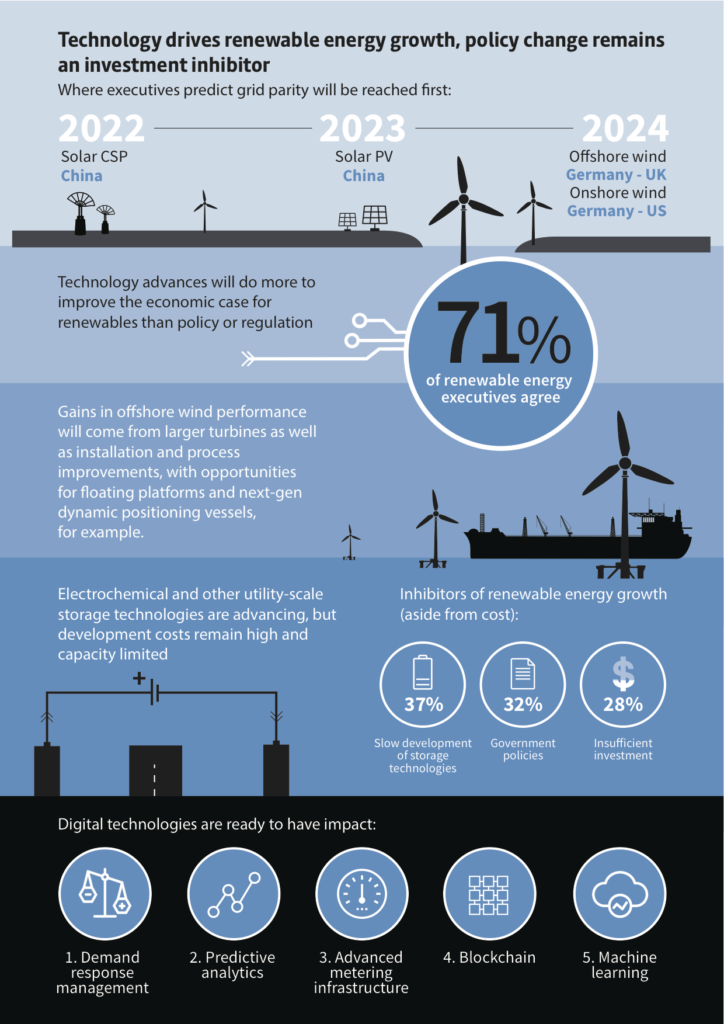Technology Radar 2018 Renewable Energy report – launched by Lloyd’s Register – analyses the sizeable renewable energy impacts in the next five years and beyond. It provides answers from leading industry experts on their optimism, concerns and investment outlook on tomorrow’s energy mix.
If there were doubts that renewable energy sources could ever compete effectively with oil, natural gas and coal in power generation, developments in the past two years should have dispelled them! But, what will it take for renewable energy to become the primary form of energy consumed?
The Lloyd’s Register 2018 Technology Radar – Renewable Energy study, published today, asks the question: when will renewable energy become the dominant source of energy?
Furthermore, the study examines which technologies are likely to have the greatest impact in different countries, and what are the key drivers and inhibitors for success.
The research sought the insights and opinions of leaders across the sector, as well as a survey of 800 professionals and experts around the world.
The survey included respondents from organisations across the renewables value chain, including traditional energy companies with renewable energy assets or activities.
Respondents were asked to give their perspective on the challenges that need to be overcome for renewables to be the primary form of energy consumed, the rate of growth in their country and to rate a number of technologies and developments in terms of their potential impact, the amount of time it would take for these technologies to hit the market, and how likely they are to be adopted once they do.
Respondents were also asked to reflect on the pace and success of innovation in their sector – and what they see as the major drivers and blockers post 2018.
Key findings include:
* Respondents expect grid parity for solar to be achieved first in China (2022), followed by Spain and UAE in 2024, and by Australia and the US in 2025. For wind power generation, grid parity is expected in Germany and UK by 2024, USA and Denmark in 2025, and in Sweden by 2033.
* Although a minority of respondents (10%) believe that renewables have already overtaken fossil fuels in their country, or will do so in the next two years, 58% believe that this milestone will not be reached until after 2025.
* Renewable economics are unquestionably improving, but 62% of respondents say that high development costs remain the primary argument against pursuing renewables in their country. However, the cost of building solar capacity for utility-scale generation has more than halved in the past 10 years, which has helped to fuel the rapid expansion of solar capacity worldwide since 2014.
* More than 45% of the surveyed executives (including 55% of those based in Europe) say that resistance to onshore wind turbines in their countries is too strong to enable significant growth from this source.
* An overwhelming 71% agree that technology advances will do more in the next five (5) years to improve the economic case for renewables than policy or regulatory changes. There is an expectation for advanced metering infrastructure (AMI), demand response management (DRM) systems, networked sensors and accuracy of asset monitoring data to have a beneficial impact on operational performance. However, 36% identify policy inconsistency as an inhibiting factor.
* 37% of respondents indicate the slow development of storage technologies as the most important factor inhibiting the growth of renewables in the energy mix. Utilities need to be able to call on energy producers for additional power whenever it is required, whether for load balancing or meeting surges. Green hydrogen provides an alternative form of storage to electrochemical batteries as hydrogen fuel cells can store power for considerably longer.
* 42% of respondents agree that reaching grid parity will not be enough to cause a sustained increase in investment in renewables. Subsidies are critical to support developments in most markets.
“Our latest Technology Radar – Renewable Energy research reflects the most current and forward-looking attitudes, actions, and investment behaviours in both global and local renewable energy markets. These trends are striving to shape tomorrow’s sustainable energy mix and are framing a clear end in sight for a big transformational shift in sustainable energy provision,” says Alasdair Buchanan, Director of Lloyd’s Register’s Energy business, a leading global provider of engineering and technology-centric professional services.
“It is this insight and the future-forward energy implications that position Lloyd’s Register’s 2018 Technology Radar Renewable Energy report as essential to investor, developer, operator and regulator strategies for the years ahead.”
Karl Ove Ingebrigtsen, Director of Lloyd’s Register’s Low Carbon Power Generation business highlights: “I am heartened by the optimistic outlook and by the measured and realistic approach that is displayed throughout the results and insights in this year’s research. It illuminates the outlook for renewable energy – and highlights the technologies that are expected to deliver the greatest impact, especially in grid transformation which must be based on a sound understanding of each country’s individual ecosystem; it is clear that this is advancing alongside technology, policy and investment.”
This is the fourth year Lloyd’s Register has conducted its award-winning Technology Radar research. Whilst earlier editions have focused on the oil and gas sector and low carbon, this time around, the research concentrates on the renewable energy sector, with particular attention to sustainable energy drivers, geo-and political demographics, energy demand, market design, policy, technology, public appetite and social licence.
The research delivers insights that will help to inform industry debate and energy policy across the world, and may help to raise further discussions on areas such as standardisation and putting a price on carbon that treats all carbon equally which is an increasing focus for industry. For oil and gas producers a standardised carbon price scheme for emissions provides a financial incentive to seek solutions through efficiency and innovation in lower carbon technologies.
“We are seeing a real shift in thinking by the oil and gas majors as they increase their renewable energy portfolio and diversify their offering in the market. The halcyon days of high oil prices scuppering renewable energy growth and development is a distant memory; the energy industry is on a new low carbon growth and efficiency drive which will change the source of our energy supply forever,” says Ingebrigsten.
To download the 2018 Technology Radar Renewable Energy report and findings, plus the Executive Summary in English, Chinese, French, German, Portuguese or Norwegian, click HERE.
 Engineer News Network The ultimate online news and information resource for today’s engineer
Engineer News Network The ultimate online news and information resource for today’s engineer




